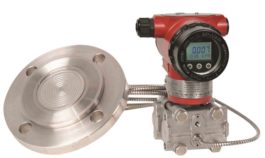Pressure
Pressure Gauges
Pressure with Liquid-filled gauges is generally preferred over dry gauges for two reasons: performance and ROI. Liquid-filled gauges are filled with a liquid, usually glycerin or silicone oil, and are designed to perform optimally in less-than-ideal conditions.
While liquid-filled gauges are engineered to function in difficult environments, they’re also more economical from a long-term perspective:
High heat, pulsation, or vibration leads to instrument breakdown, but liquid-filled gauges stand up to these harsh conditions.
Liquid Filled vs. Traditional Gauges
The primary reason for gauge failure is vibration. In traditional dry gauges, delicate links, pivots, and pinions are prone to damage from vibration, leading to inconsistent performance. In a liquid-filled gauge, the fluid fill effectively dampens system pulsation, making the gauge pointer easier to read.
Likewise, humidity and moisture pose problems for dry gauges. Condensation can make a gauge difficult to read or, in some cases, can cause failure due to icing. Liquid-filled gauges, though, are sealed to prevent internal condensation, and by keeping moisture out of the system, gauge movement is protected during icing conditions.
The choice of fill fluid is based on the application, but glycerin is typically used for room-temperature applications, and silicone oil is commonly used for extreme-temperature applications, especially when icing is a problem. An oil with insulating properties is ideal if the system has exposed electrical contacts.
Why Liquid Filled?
Liquid-filled gauges offer several advantages over traditional, dry-case pressure gauges:
Liquid-filled gauges have longer lives than traditional (non-hermetically-sealed) gauges because of their viscous fluid filling. Over time, this design advantage results in cost savings due to lowered instrumentation costs as well as lessened unscheduled downtime.
Internal liquids protect against severe temperature fluctuations and vibrations—major factors in the breakdown of regular gauges. Because they dampen temperature spikes and vibrations, liquid-filled gauges are easier to read, allowing for greater accuracy and process control.
In traditional gauges, condensation build-up results in visibility issues. This can be a crucial (and costly) flaw in high-humidity environments—an unreadable gauge is a worthless gauge.
A solution to the impact of high humidity situations, liquid-filled gauges are designed to prevent moisture from entering not only the body casing but also the inside of the case lens.
Because they are sealed and constructed to meet rugged specifications, liquid-filled gauges are commonly used in highly corrosive chemical processes or in manufacturing or refining processes, where products must be transported, stored, or handled in extreme temperature conditions.
Liquid-filled Gauges
While some customers are concerned about the cost of liquid filling for a pressure gauge, the long-term payoff is clear:
Better protection against vibration, pulsation, corrosion, and moisture makes for a long-lasting, reliable instrument. liquid-filled gauges are highly durable, meaning less cost and better accuracy over time, and our line includes several customizable process gauges, including gauges built for the demanding conditions of the oil and gas industry.
Pressure Transmitters
A pressure sensor is a device for pressure measurement of gases or liquids. Pressure is an expression of the force required to stop a fluid from expanding, and is usually stated in terms of force per unit area.
A pressure sensor usually acts as a transducer; it generates a signal as a function of the pressure imposed. For this article, such a signal is electrical.
Pressure Transmitter
A pressure transmitter or pressure sensor is a device that measures pressure in a liquid, fluid, or gas. Pressure transmitters are commonly used to measure pressure inside industrial machinery to alert the user before a catastrophe occurs.
Differential Pressure Level Transmitter
Differential Press (DP) Level Measurement uses pressure readings and specific gravity to output level. DP Level is a common measurement technique that is used in a wide variety of applications. Solutions include standard transmitter connections and integrated transmitters with direct or remote mount seals that can be configured in tuned, balanced, and electronic systems.
Differential Pressure Transmitter
Differential Pressure (DP) transmitters measure the difference between two presses with attached remote diaphragm. They use a reference point called the low side and compare it to the high side, both being diaphragms. Ports in the instrument are marked high-side and low-side directly on the flanges or tri-clamp connections.
The DP reading can be either negative or positive depending on whether the low-side or high-side is the larger value and it is also configurable in the settings of the device. A DP transmitter can be used as a gauge pressure transmitter if the low side is left open to the atmosphere.
Showing all 6 resultsSorted by popularity
-

Pressure Transmitter
Price range: $ 889.00 through $ 1,745.00Select options This product has multiple variants. The options may be chosen on the product page -
Sale

Liquid Filled Pressure Gauges
Price range: $ 27.00 through $ 34.00Select options This product has multiple variants. The options may be chosen on the product page -

Pulsation Dampers
Price range: $ 649.00 through $ 2,881.00Select options This product has multiple variants. The options may be chosen on the product page -

Wireless Pressure Transmitter
Price range: $ 375.00 through $ 1,148.00Select options This product has multiple variants. The options may be chosen on the product page -

Pressure Level Transmitter
Price range: $ 1,092.00 through $ 2,111.20Select options This product has multiple variants. The options may be chosen on the product page -

Differential Pressure Transmitter
Price range: $ 1,132.75 through $ 1,650.25Select options This product has multiple variants. The options may be chosen on the product page
